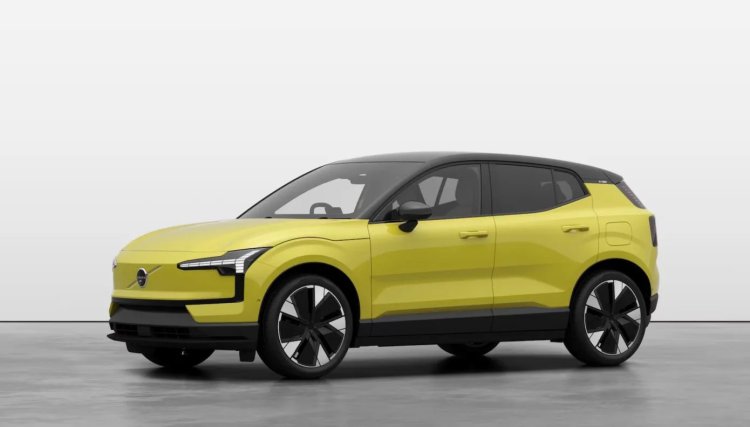The Significance of the All-Electric Volvo EX30
Volvo's Shift: From the XC90 to the EX30, a Decade of Transformation

Around ten years ago, Volvo embarked on a modernization journey that marked a substantial departure from its conventional image. The launch of the second-generation XC90 crossover in 2015 signaled a brand renaissance, shedding the stereotype of boxy station wagons. This reinvention showcased pioneering hybrid powertrains, captivating design, and an expansive tablet-like central screen that seemed inspired by Tesla's playbook.
Fast forward to the present day, and Volvo's upcoming sensation isn't a large luxury vehicle, but a compact and budget-friendly model – the EX30. Recently unveiled in New York for the North American market, the EX30 is a vehicle full of pioneering features. It stands as Volvo's inaugural compact, fully electric crossover, boasting unparalleled speed and an innovative interior crafted from sustainable materials. This unique blend positions the EX30 as a contender for mass-market success, representing a significant evolution for the brand.
A Noteworthy Entry into the Electric Domain
Initial reactions to the EX30 have surpassed all expectations, according to David Mele, the EX30's Product Manager for the United States. The car's affordability is a major drawcard, starting at just $34,950, making it one of the most accessible electric vehicle (EV) options in the United States. As the EV market experiences fluctuations in demand, with concerns over pricing and economic stability, the EX30's price point significantly undercuts the average $53,000 tag of comparable EVs.
In a landscape where affordable EV choices are scarce, including the Tesla Model 3 and Model Y, as well as the Chevrolet Bolt, the EX30 emerges as a game-changer. This compact model squarely hits the sweet spot for potential EV enthusiasts, as demonstrated by a survey by data firm AutoPacific that identified a $35,000 price range as the tipping point for widespread EV adoption.
Breaking Boundaries and Redefining Volvo's Identity
With the EX30, Volvo is taking calculated risks, leveraging its electric powertrain to capture a new audience. The target demographic for the EX30 encompasses pre-family individuals, parents, and grandparents. It is envisioned as a secondary or tertiary vehicle, potentially serving as buyers' inaugural EV experience and their first encounter with the Volvo brand.
Unlike earlier attempts at compact cars, the EX30 represents a bold stride for Volvo. Previous endeavors like the compact C30 hatchback and V50 didn't attain significant sales momentum. The EX30 aims to change this narrative, targeting a broader consumer base and pursuing mass-market appeal.
A Shift Towards Electric Dominance
The EX30's release aligns with Volvo's broader objectives of transitioning to a "half-electric" lineup by 2025 and achieving full electrification by 2030. These ambitions align with Volvo's parent company, Geely Holding Group, which encompasses various brands, including the performance-oriented Polestar and the traditional British marque Lotus. Geely's expansive influence reflects a concerted effort to expand its presence on the global automotive stage.
Produced in China, the EX30 carries the distinction of being subject to a 27.5% tariff on Chinese-made vehicles, a detail that enhances the model's remarkable pricing strategy. Although Volvo is yet to announce long-term production plans, the possibility of North American manufacturing remains open, echoing the trend set by other competitors to localize production and reduce carbon emissions.
Embracing the Electric Future
Boasting multiple battery options and powertrain configurations, the EX30 demonstrates its technological prowess. The vehicle offers a 69 kWh nickel-cobalt-manganese battery for North America, alongside a more affordable 51 kWh lithium-iron-phosphate option for other markets. The EX30's powertrain variants range from a single-motor, rear-wheel drive model to a performance-oriented twin-motor, all-wheel drive version, showcasing impressive acceleration and capabilities that no previous Volvo model has matched.
The EX30's tech-forward cabin features a vertical 12.3-inch touchscreen, reminiscent of Tesla's design, powered by Google's Android operating system. Standard features include wireless Apple CarPlay, wireless phone charging, 5G connectivity, over-the-air software updates, USB-C ports, and rapid charging capabilities.
Incorporating Innovation and Identity
Despite its compact size and affordability, the EX30 emerges as a compelling package, defying the notion of a basic economy car. Its vibrant color choices and engaging design, such as Cloud Blue and Moss Yellow, set it apart. The EX30 is anticipated to launch next summer, with plans to enable access to Tesla's Supercharger network through an adapter in 2024, eventually becoming a standard feature from 2025 onward. This move amplifies the EX30's allure as an appealing entry point into the world of EVs.
In essence, Volvo's EX30 embodies more than just a compact electric vehicle; it symbolizes the brand's determined shift towards a more electrified future, appealing to a wider audience and fostering innovation while embracing its distinct Swedish heritage.

 chandni
chandni 



